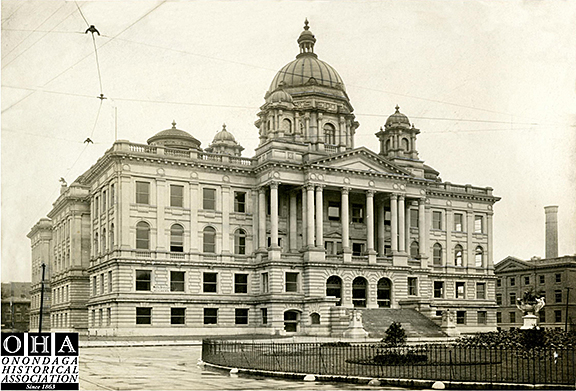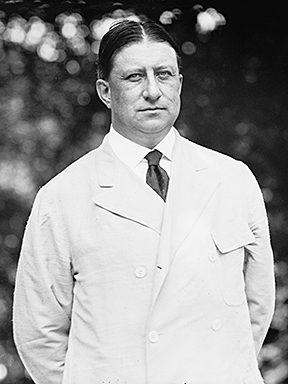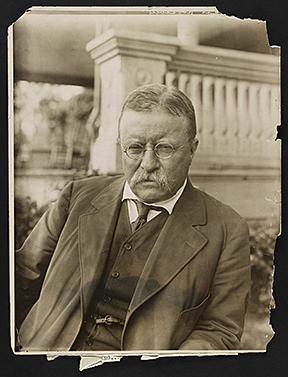Theodore Roosevelt for the Defense The Courtroom Battle to Save His Legacy
Theodore Roosevelt for the Defense The Courtroom Battle to Save His Legacy by Dan Abrams & Davis Fisher by Guest Writer: John Sposato
 I’ve been involved with presentations for the Onondaga Historical Association (OHA) for twelve years now, mostly with the Ghost Walks that are presented annually in Oakwood Cemetery, downtown and various neighborhoods. When not performing a reenactment of a former resident I often tour guide groups through the Ghost Walks.
I’ve been involved with presentations for the Onondaga Historical Association (OHA) for twelve years now, mostly with the Ghost Walks that are presented annually in Oakwood Cemetery, downtown and various neighborhoods. When not performing a reenactment of a former resident I often tour guide groups through the Ghost Walks.
There were three Ghost Walks in 2022, one at Oakwood in May, and two downtown in July and September. The September tour featured what has become one of my all-time favorite re-enactments. It was titled “The Trial of The Century,” and it featured two attorneys who were representing opposing sides in a trial that was about to begin in the still-new 4th Onondaga County Courthouse. The re-enactment portrayed a chance meeting. The two attorneys had known each other and had been friends for years. Their exchange was a sparring of accusations and defense of their respective clients and made a fascinating debate.
I found it so interesting that I decided to read the book written about it.
The trial’s plaintiff was William Barnes, a political boss in the Republican Party in the early part of the 1900s who had great political influence in New York, and who sued Theodore Roosevelt (TR), the defendant) for libel. Barnes claimed that TR falsely reported that he was “politically corrupt.”
TR had no problem admitting that he wrote, and made public through written articles, and in a speech the prior year that the political system of the day and its leaders were corrupt and abused their power for personal gain, referencing Barnes as among them. What was in place was an “invisible government” that resulted in “mal-administration and corruption in public offices of the state.”
The trial began in April, 1915. It was originally scheduled to be heard in Albany. But TR’s attorneys claimed that an impartial jury could not be found there, hence it was transferred to Syracuse to be heard in the 4th Onondaga County Courthouse.
For libel, at least during this era, the defendant is considered guilty until proven innocent. The question for the jury was not to decide if the statements were accurate or not, but rather if they were made with malicious intent and libelous. In other words, was what TR saying true?
The trial gained national attention with newspapermen from all over the country in attendance every day. This was to be a grand performance for TR. The former president was as boisterous and feisty as ever, and was ready for a fight. He was still a beloved and legendary personality who was not only a former governor of New York and a former President, but also the hero of San Juan Hill in The Spanish American War and a great adventurer. He was a much beloved and popular figure with great influence in New York State politics, and upon its voters. He was not only fighting off a $50,000 lawsuit (about $2,000,000 in 2022 dollars) but his political legacy, honor and reputation as well.
In 1912 he left the Republican Party and formed his own party, commonly known as The Bull Moose Party for which he outdistanced the Republican candidate William Taft in the race for president that year. This split in the Republican party allowed Woodrow Wilson, a Democrat, to be elected president. That was only three years before the lawsuit, and TR’s popularity was still high and the public found him to be “charismatic and entertaining.”
William Ivins represented Barnes and John Bowers represented TR. These two lawyers were considered among the best legal minds in the country, and both had their team of supporting attorneys.
The trial turned out to be more than either Barnes or TR had expected. It basically became an exposé of what American politics was behind the scenes. TR was claiming that decisions in the government of New York were not made by the governor or elected representatives but rather by backroom “bosses.” Both Republican and Democrat bosses were accused of employing these tactics, and deals were made between them that would favor their interests and keep contributions from large donors for elections in place. And of course, these donors would contribute to the candidates that would best serve their financial interests.

TR claimed that because of these irregularities, the people’s interests were ignored. He took every opportunity to show how this had happened in the past, over and over again, and that political corruption went hand-in-hand with the financial corruption that fed off government contracts, special favors and payments to the bosses and their friends. TR claimed that his “Progressive” policy and style of government did not incorporate these methods, but governed in the best interest of the people, with their knowledge and consent. His approach called for a party leader instead of a party boss.
Barnes, of course, denied all this, but as the book relates he slipped when it was discovered he was quoted as saying, “The people are not fit to govern themselves, but must be governed by party organization.” Overwhelming proof was presented of him being awarded lucrative printing contracts from the state, and defaulting on them, but the judge ordered it stricken from the record and to be ignored by the jury. Can a jury really do that? Especially when it favors TR?
Countless witnesses were brought to testify for both sides. Each was examined, cross-examined, and sometimes seated twice. The objections to the questioning were constant. Both Barnes and TR had their opportunity on the witness stand as well. As the authors portray it, TR was quite dramatic with his gestures and loud exclamations and the jury found him quite amusing at times. The presiding Supreme Court Judge, William Andrews, had to silence the courtroom frequently, and even threatened to empty it.
TR put up a strong defense, but many times he got caught up in his own rhetoric. William Ivers, attorney for the plaintiff, is also described as a good showman, and the exchange between the two was a challenge to each. Iver’s questioning was trying to prove the point that TR was guilty and profited politically from the same system that he was claiming was corrupt.
The trial lasted five weeks. Deliberations took 42 hours, and on May 22 the jury ruled in favor of the defendant. The press hailed the decision. Outlook, a political publication of the day, reported that the verdict was a “triumph of the right of free speech of the jury system and of responsible government…and of defining the difference between a party boss and a party leader who was working with the public welfare in mind.”

I have my own view of TR, the case brought against him and his defense, but reading this book is your chance to make your own decision. Read, and then consider the following, as I am sure the jury did: Was Barnes any more guilty than anyone else who was in a ruling position of a political party? Was TR the end result of the system that was in place, which he claimed was corrupt? Did he take advantage of the paths that were set out for him or did he achieve all of his political success on his own? Was TR found innocent because the case he presented brought out the truth? Because of the testimonies of the witnesses? Or did he win because of his overwhelming popularity?
No appeals were made. This was TR’s last hurrah. He continued to be a strong advocate for war with Germany. He even asked President Wilson if he could command an independent regiment once the war was declared. Barnes lost his leadership position in the Republican party but continued to work with them.
The book is available at The OHA Museum and Bookstore at 321 Montgomery St. Pick up a copy, and reach your own decision – and while you’re at it, enjoy the many fascinating exhibits at the Museum!











